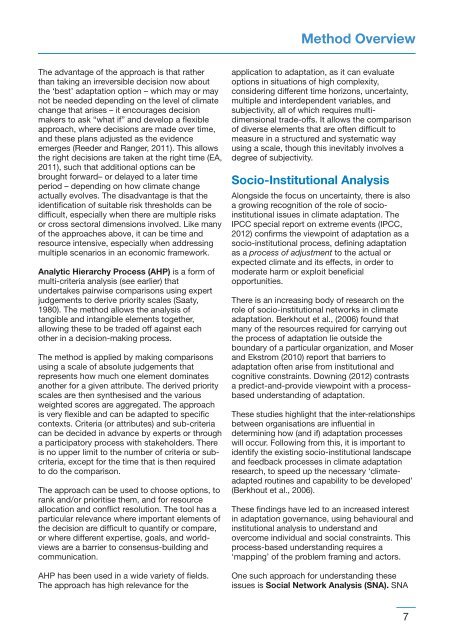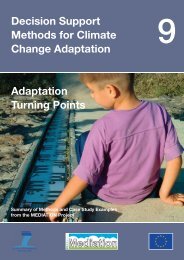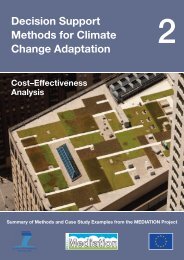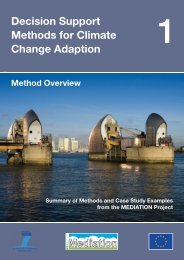Download all Technical Policy Briefing Notes in a single ... - Mediation
Download all Technical Policy Briefing Notes in a single ... - Mediation
Download all Technical Policy Briefing Notes in a single ... - Mediation
- No tags were found...
Create successful ePaper yourself
Turn your PDF publications into a flip-book with our unique Google optimized e-Paper software.
Method OverviewThe advantage of the approach is that ratherthan tak<strong>in</strong>g an irreversible decision now aboutthe ‘best’ adaptation option – which may or maynot be needed depend<strong>in</strong>g on the level of climatechange that arises – it encourages decisionmakers to ask “what if” and develop a flexibleapproach, where decisions are made over time,and these plans adjusted as the evidenceemerges (Reeder and Ranger, 2011). This <strong>all</strong>owsthe right decisions are taken at the right time (EA,2011), such that additional options can bebrought forward– or delayed to a later timeperiod – depend<strong>in</strong>g on how climate changeactu<strong>all</strong>y evolves. The disadvantage is that theidentification of suitable risk thresholds can bedifficult, especi<strong>all</strong>y when there are multiple risksor cross sectoral dimensions <strong>in</strong>volved. Like manyof the approaches above, it can be time andresource <strong>in</strong>tensive, especi<strong>all</strong>y when address<strong>in</strong>gmultiple scenarios <strong>in</strong> an economic framework.Analytic Hierarchy Process (AHP) is a form ofmulti-criteria analysis (see earlier) thatundertakes pairwise comparisons us<strong>in</strong>g expertjudgements to derive priority scales (Saaty,1980). The method <strong>all</strong>ows the analysis oftangible and <strong>in</strong>tangible elements together,<strong>all</strong>ow<strong>in</strong>g these to be traded off aga<strong>in</strong>st eachother <strong>in</strong> a decision-mak<strong>in</strong>g process.The method is applied by mak<strong>in</strong>g comparisonsus<strong>in</strong>g a scale of absolute judgements thatrepresents how much one element dom<strong>in</strong>atesanother for a given attribute. The derived priorityscales are then synthesised and the variousweighted scores are aggregated. The approachis very flexible and can be adapted to specificcontexts. Criteria (or attributes) and sub-criteriacan be decided <strong>in</strong> advance by experts or througha participatory process with stakeholders. Thereis no upper limit to the number of criteria or subcriteria,except for the time that is then requiredto do the comparison.The approach can be used to choose options, torank and/or prioritise them, and for resource<strong>all</strong>ocation and conflict resolution. The tool has aparticular relevance where important elements ofthe decision are difficult to quantify or compare,or where different expertise, goals, and worldviewsare a barrier to consensus-build<strong>in</strong>g andcommunication.AHP has been used <strong>in</strong> a wide variety of fields.The approach has high relevance for theapplication to adaptation, as it can evaluateoptions <strong>in</strong> situations of high complexity,consider<strong>in</strong>g different time horizons, uncerta<strong>in</strong>ty,multiple and <strong>in</strong>terdependent variables, andsubjectivity, <strong>all</strong> of which requires multidimensionaltrade-offs. It <strong>all</strong>ows the comparisonof diverse elements that are often difficult tomeasure <strong>in</strong> a structured and systematic wayus<strong>in</strong>g a scale, though this <strong>in</strong>evitably <strong>in</strong>volves adegree of subjectivity.Socio-Institutional AnalysisAlongside the focus on uncerta<strong>in</strong>ty, there is alsoa grow<strong>in</strong>g recognition of the role of socio<strong>in</strong>stitutionalissues <strong>in</strong> climate adaptation. TheIPCC special report on extreme events (IPCC,2012) confirms the viewpo<strong>in</strong>t of adaptation as asocio-<strong>in</strong>stitutional process, def<strong>in</strong><strong>in</strong>g adaptationas a process of adjustment to the actual orexpected climate and its effects, <strong>in</strong> order tomoderate harm or exploit beneficialopportunities.There is an <strong>in</strong>creas<strong>in</strong>g body of research on therole of socio-<strong>in</strong>stitutional networks <strong>in</strong> climateadaptation. Berkhout et al., (2006) found thatmany of the resources required for carry<strong>in</strong>g outthe process of adaptation lie outside theboundary of a particular organization, and Moserand Ekstrom (2010) report that barriers toadaptation often arise from <strong>in</strong>stitutional andcognitive constra<strong>in</strong>ts. Down<strong>in</strong>g (2012) contrastsa predict-and-provide viewpo<strong>in</strong>t with a processbasedunderstand<strong>in</strong>g of adaptation.These studies highlight that the <strong>in</strong>ter-relationshipsbetween organisations are <strong>in</strong>fluential <strong>in</strong>determ<strong>in</strong><strong>in</strong>g how (and if) adaptation processeswill occur. Follow<strong>in</strong>g from this, it is important toidentify the exist<strong>in</strong>g socio-<strong>in</strong>stitutional landscapeand feedback processes <strong>in</strong> climate adaptationresearch, to speed up the necessary ‘climateadaptedrout<strong>in</strong>es and capability to be developed’(Berkhout et al., 2006).These f<strong>in</strong>d<strong>in</strong>gs have led to an <strong>in</strong>creased <strong>in</strong>terest<strong>in</strong> adaptation governance, us<strong>in</strong>g behavioural and<strong>in</strong>stitutional analysis to understand andovercome <strong>in</strong>dividual and social constra<strong>in</strong>ts. Thisprocess-based understand<strong>in</strong>g requires a‘mapp<strong>in</strong>g’ of the problem fram<strong>in</strong>g and actors.One such approach for understand<strong>in</strong>g theseissues is Social Network Analysis (SNA). SNA7





